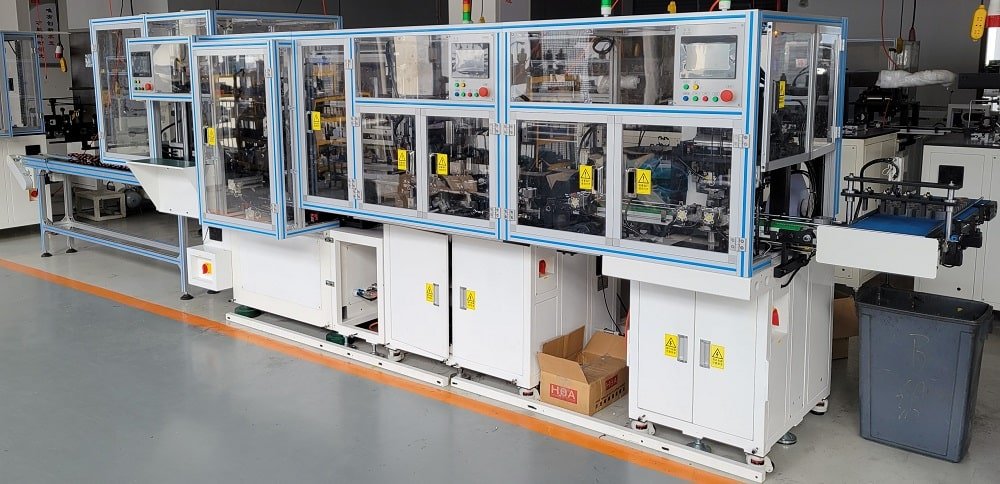Many motor manufacturers are beginning to use production line equipment for rotor assembly. The primary goal of adopting automated rotor assembly lines is to improve production efficiency and quality. Vacuz offers a systematic solution for optimizing efficiency, quality, and cost in automated rotor assembly lines, integrating four core dimensions and implementing a path. We hope this helps!

Vacuz Two Stations Automatic Correction FPV Drone External Rotor Ring Drilling Milling Weight Removing Motor Balancing Machine
I. Improving Production Efficiency: Automation and Collaborative Optimization
1. Equipment Automation Upgrade
Multi-station Parallel Operation: A rotary/linear multi-station turntable is used to simultaneously perform core insertion, winding, and welding processes (for example, a six-station design can reduce cycle time by 38%).
High-speed Motion Control: A servo motor + high-precision encoder achieves high-speed positioning (increasing speed by 50%), while a pneumatic-hydraulic booster cylinder reduces press-fitting time to 1.2 seconds per stroke.
Flexible Design: Modular fixtures enable rapid changeover within 10 minutes, accommodating multi-product production.
2. Process Optimization
Process Reorganization: Through VSM analysis, redundancies are eliminated and series operations are shifted to parallel operations (for example, simultaneous welding and balancing).
Smart Scheduling: The MES system dynamically adjusts plans, reducing equipment idleness and material waiting times.
3. Logistics Automation
AGV/RGV Delivery: Handling time is reduced from 15 minutes to 3 minutes per load.
Buffer Bin Design: Balances process cycle variations and avoids downtime.
II. Precision Quality Control: Defect Prevention and Standardization
1. Online Inspection Technology
Machine Vision: High-speed cameras inspect windings, solder joints, and other components, achieving a defect detection rate of ≥99.5%.
Force Control Sensor: Press-fitting force is controlled at 500±20N to prevent core deformation or loosening.
Dynamic Balancing: An automatic de-weighting machine controls residual unbalance to ≤2g·cm.
2. Process Standardization
Process Database: Records parameters such as winding tension and soldering temperature, creating SOPs to mitigate human error.
SPC Monitoring: Provides real-time warnings of parameter fluctuations and proactively intervenes in anomalies.
3. Error-Proofing Design
Tooling Error-Proofing: Positioning pins and sensors ensure correct core orientation, and polarity detection prevents reverse connection.
Material Error-Proofing: Barcode scanning matches the BOM to prevent misuse.
III. Lean Cost Control: Resource and Efficiency Optimization
1. Improved Equipment Efficiency
TPM Maintenance: Daily cleaning and regular lubrication have reduced the failure rate from 5% to 1%.
Predictive Maintenance: Vibration/temperature sensors provide early warning of failures, reducing downtime.
Improved Yield: The quality traceability system analyzes root causes, increasing the yield rate from 95% to 98.5%.
2. Material Cost Optimization
Centralized Procurement: Long-term agreements reduce raw material costs by 8%-12%, and the VMI model increases inventory turnover by 30%.
Waste Recovery: Reusing short thread ends reduces waste.
3. Energy and Labor Conservation
Energy-Saving Retrofit: IE4/IE5 motors + inverters save 15%-20% in electricity and reduce compressed air leakage from 25% to 5%.
Multi-Skilled Worker Training: Automated operations reduce staff to 8 people per line, and employees are trained in multiple skills to increase per capita output.
IV. Implementation Results and Enhanced Competitiveness
Efficiency: Production cycle shortened by over 50%, and Overall Equipment Effectiveness (OEE) increased by 30%.
Quality: Defective rates decreased by 70%, and dynamic balancing compliance rates reached ≥99.8%.
Cost: Unit costs decreased by 15%-20%, resulting in significant annual energy savings.
Key Success Factors
Technology Integration: Automation equipment must be deeply integrated with systems such as MES and SPC.
Continuous Improvement: Optimize process parameters and error-proofing measures through the PDCA cycle.
People Empowerment: Strengthen multi-skilled worker training and introduce a lean culture.

Линия по производству статорных катушек щеточных двигателей
How can you improve the efficiency and quality of rotor assembly lines? How can you reduce costs? Vacuz has provided a brief explanation. We hope this information is helpful!
Электронная почта: sales@vacuz.com





